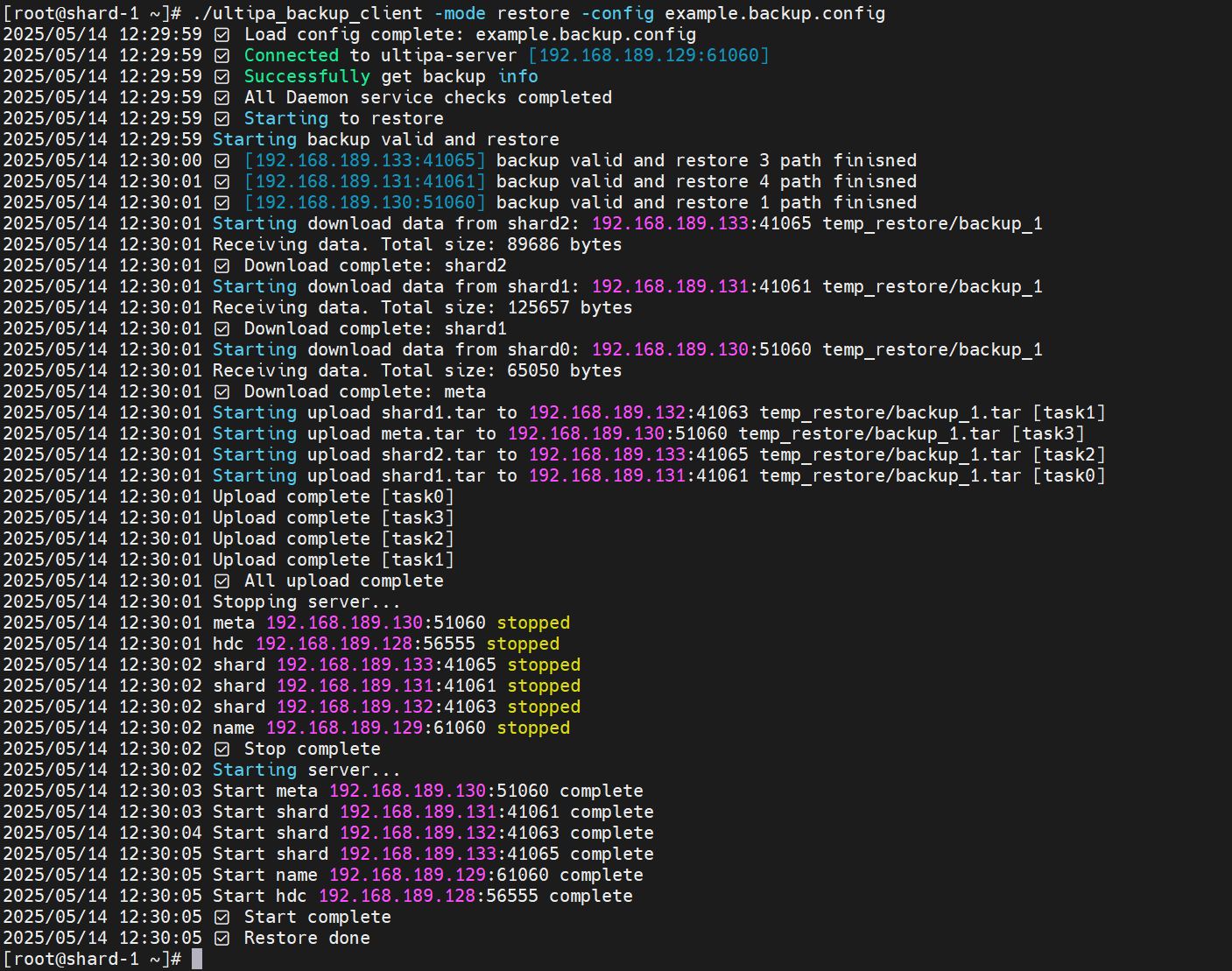Backing up the database is essential to protect data integrity, prevent data loss, and ensure disaster recovery in case of hardware failure, accidental deletion, or corruption. It also enables database migration, replication, and rollback to a previous state if needed.
You can create a backup from a running database using either UQL or the ultipa_backup_client tool. The backup includes user-created graphs on Shard servers and system global graphs on both Shard and Meta servers. To restore a backup, you can only use the ultipa_backup_client.
Using UQL
Create a Backup
Create a backup named backup-20250101:
db.backup.create("backup_20250101")
The backup creation is executed as a global job, you may run show().job().global() afterward to verify the success of the creation.
If the specified backup name already exists, differential backup is performed; otherwise, a full backup is created.
View Backups
Retrieves all backups created for the database:
db.backup.show()
Or retrieves a specific backup, such as the one named backup_20250101:
db.backup.show("backup_20250101")
It returns a table _backupList with the following fields:
Field |
Description |
|---|---|
backup_name |
Backup name. |
backup_uuid |
Backup _uuid |
start_time |
The timestamp when the backup creation begins. |
end_time |
The timestamp when the backup creation ends. |
status |
Current status of the backup, which can be DONE, RUNNING or FAILED. |
msg |
Error message of the backup creation. |
backup_infos |
Backup information for each graph, including:
Note: The default setting of the db_backup_path is backup_data. You can find this directory in the default working directory of the container. |
Using the Client
Ultipa Backup Client (ultipa_backup_client) is a cross-platform (Windows/Mac/Linux) command line interface designed for managing and restoring backups for Ultipa graph databases.
Prerequisites
- A command line terminal.
- Linux or MacOS: Bash, Zsh, TCSH
- Windows: PowerShell
- Download Ultipa Backup Client from here. No installation is required.
The following examples are demonstrated using a Bash shell on Linux.
Navigate to the directory containing the ultipa_backup_client. Ensure it has the appropriate execute permissions by running:
chmod +x ultipa_backup_client
Generate Configuration File
Run the command to generate a sample configuration file:
./ultipa_backup_client -sample

A file named example.backup.config will be generated in the same directory as ultipa_backup_client. If the file already exists, it will be overwritten.
Create a Backup
To create a backup, modify the [server] section in the example.backup.config file based on your environment.
Example:
[server]
; database host (name server address)
host = 192.168.189.129:61060
; database username
username = root
; database password
password = <password>
; backup name (supports only letters, numbers, and underscores)
name = backup_1
Other settings in example.backup.config are not used when creating a backup.
Run the command to create a backup:
./ultipa_backup_client -mode backup -config example.backup.config
If the specified backup name already exists, differential backup is performed; otherwise, a full backup is created.

View Backups
Run the command to view the information of all backups:
./ultipa_backup_client -mode backup_info -config example.backup.config

The backup_info column is omitted here. To view detailed backup information, run the UQL statement db.backup.show() in the database.
Restore a Backup
A backup artifact can be restored within the same database.
To restore a backup, you need to further modify the example.backup.config file based on your environment.
Notes:
- The
namein[server]section must match theuuidin[restore]section to correctly identify the backup. - The
shard-datain[restore]section must match thedbpathof your Shard servers (default:shard_data). - The
meta-datain[restore]section must match thedbpathof your Meta servers (default:data). - For Shard, Meta, Name, or HDC clusters, the order of server addresses and daemon addresses must correspond exactly. All replicas in a shard must be included.
- Daemon Address Configuration:
- Each server's daemon address is configured in
backup.configfile located in the container'sconfigdirectory. This file is automatically generated during first startup with the default settinglisten = :50051, and it uses the machine's primary IP address. - Modify
backup.configto resolve port conflicts (format:ip:portor:port) if needed.
- Each server's daemon address is configured in
- Omit the
[hdc]section entirely if no HDC servers are deployed.
Example:
[server]
; database host (name server address)
host = 192.168.189.129:61060
; database username
username = root
; database password
password = <password>
; backup name (supports only letters, numbers, and underscores)
name = backup_1
[restore]
; backup uuid for restore (must match the specified backup name)
uuid = T20250514031515_N1_158_6
; shard server dbpath
shard-data = shard_data
; meta server dbpath
meta-data = data
; shard config for restore
[shard]
; all replica addresses for shard-1
shard1-address = 192.168.189.131:41061,192.168.189.132:41063
; all daemon addresses for shard-1
daemon1-address = 192.168.189.131:50051,192.168.189.132:50051
; all replica addresses for shard-2
shard2-address = 192.168.189.133:41065
; all daemon addresses for shard-2
daemon2-address = 192.168.189.133:50051
; meta config for restore
[meta]
; all meta addresses
meta-address = 192.168.189.130:51060
; all daemon addresses for meta server
daemon-address = 192.168.189.130:50051
; name config for restore
[name]
; all name server addresses
name-address = 192.168.189.129:61060
; all daemon addresses for name server
daemon-address = 192.168.189.129:50051
; hdc config for restore, if exists
[hdc]
; all hdc addresses
hdc-address = 192.168.189.128:56555
; all daemon addresses for hdc sever
daemon-address = 192.168.189.128:50051
Run the command to restore the database to the specified backup:
./ultipa_backup_client -mode restore -config example.backup.config
Note: All servers will be stopped and restarted as part of the restoration process.

All Flags
ultipa_backup_client supports the following flags:
Flag |
Parameter |
|---|---|
-mode |
Specifies the operation mode: backup, backup_info, or restore. |
-config |
Specifies path to the configuration file (default: backup.config). |
-sample |
Generates a sample configuration file (example.backup.config). |
-version |
Displays the version of ultipa_backup_client. |

